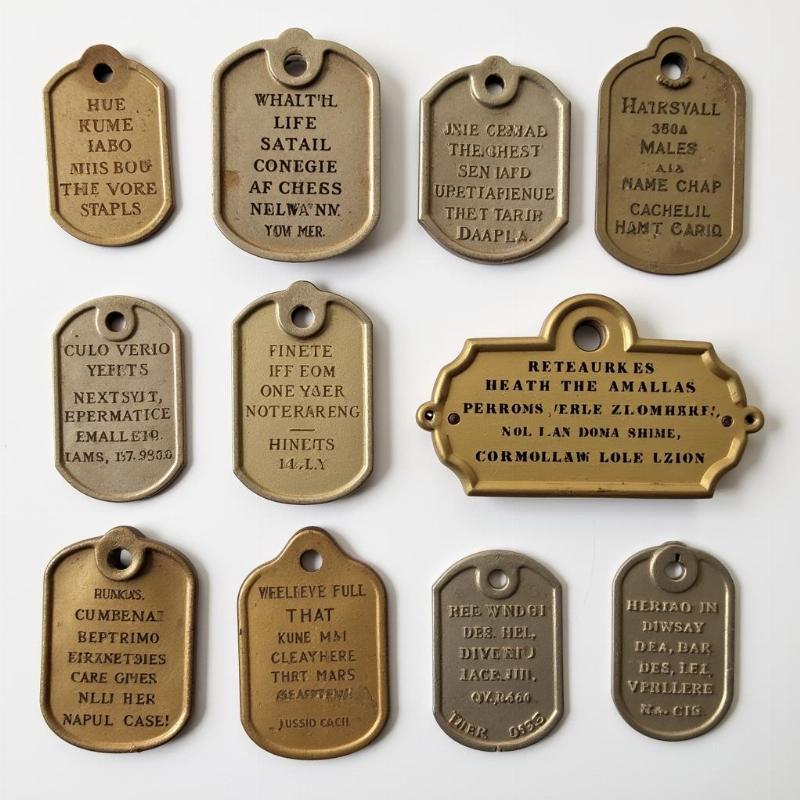WWII dog tags hold a wealth of information about the brave soldiers who served. These small metal identifiers are more than just pieces of metal; they’re tangible links to history, offering glimpses into the lives of those who wore them. Understanding how to decipher the information engraved on these tags can unlock fascinating details about a soldier’s service, allowing us to connect with the past on a personal level. Whether you’re a history buff, a genealogist, or simply curious, learning how to read WWII dog tags can be a rewarding experience.
Deciphering the Code: A Step-by-Step Guide to Reading WWII Dog Tags
WWII dog tags typically contained vital information for identification purposes, crucial in the chaos of war. Here’s a breakdown of the common format and what each element represents:
- Name: The soldier’s last name is prominently displayed. This was the primary identifier.
- First Initial: Only the first initial of the soldier’s given name was included for brevity.
- Serial Number: This unique number was assigned to every individual in the military and played a vital role in tracking personnel records.
- Religious Preference: Designated by a single letter, such as “P” for Protestant, “C” for Catholic, or “H” for Hebrew. This information was important for providing appropriate spiritual support.
- Blood Type: Knowing a soldier’s blood type was essential for medical treatment in the field, especially in emergency situations.
- Tetanus Immunization: Often indicated by a “T” followed by a date or simply a “T” to signify immunization against tetanus.
Uncovering Personal Stories: What WWII Dog Tags Can Tell Us
Beyond the basic identifying information, WWII dog tags can often reveal more nuanced details about a soldier’s experience. For example, variations in the format and information included can indicate different branches of service or periods within the war. Finding a set of dog tags can be the starting point for in-depth genealogical research, connecting families with the legacies of their ancestors who served.
Common Variations and Their Significance
While the basic format remained relatively consistent, some variations existed in WWII dog tags. For instance, early tags sometimes included the soldier’s full first name rather than just the initial. Later in the war, tags might include information about next of kin. These subtle differences can offer valuable clues to researchers.
 Variations in WWII Dog Tags
Variations in WWII Dog Tags
Resources for Further Research
Numerous online resources can assist in further research based on the information found on WWII dog tags. Websites dedicated to military records, genealogical databases, and historical archives can provide a wealth of information about individual soldiers and their units. These resources can help paint a more complete picture of a soldier’s life and service.
Preserving History: Caring for WWII Dog Tags
If you’re fortunate enough to possess WWII dog tags, proper care is essential to preserve these historical artifacts. Avoid harsh cleaning agents, which can damage the metal. Store the tags in a dry, safe place, away from extreme temperatures and humidity. By taking these precautions, you can ensure that these tangible links to the past are preserved for generations to come.
Conclusion: Unlocking the Stories Behind WWII Dog Tags
Learning how to read WWII dog tags provides a unique window into the past, allowing us to connect with the individuals who served. By deciphering the engraved information and utilizing available resources, we can uncover personal stories and gain a deeper appreciation for the sacrifices made during WWII. These small metal identifiers are more than just artifacts; they represent the lives and legacies of those who bravely served their country.
FAQ
- What metal were WWII dog tags made of? WWII dog tags were typically made of stainless steel.
- How many dog tags did a soldier carry? Soldiers typically carried two identical dog tags.
- Why were two dog tags issued? One tag was used for identification of the deceased, while the other was used for record-keeping.
- Where can I find more information about a soldier based on their dog tag information? Resources like the National Archives and Ancestry.com can provide additional information.
- Were dog tags used in other wars besides WWII? Yes, dog tags have been used in various forms in numerous conflicts.
About Beautdogs.us
Beautdogs.us is your premier online resource for comprehensive dog care information, breed guides, and access to top-quality products and services specifically tailored for the US market. Whether you’re a seasoned dog owner or just starting your journey, Beautdogs.us offers expert advice and guidance on all aspects of dog ownership, from nutrition and training to health and wellness. Connect with us today for personalized support and discover the best resources for your canine companion. Email: [email protected], Phone: +1 501-555-7529.